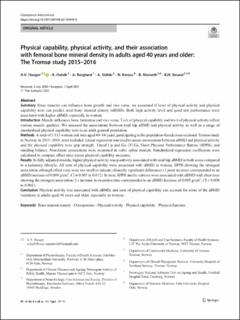| dc.contributor.author | Hauger, Annette Vogt | |
| dc.contributor.author | Holvik, Kristin | |
| dc.contributor.author | Bergland, Astrid | |
| dc.contributor.author | Ståhle, Agneta | |
| dc.contributor.author | Emaus, Nina | |
| dc.contributor.author | Morseth, Bente | |
| dc.contributor.author | Strand, Bjørn Heine | |
| dc.coverage.spatial | Norway, Tromsø. | en_US |
| dc.date.accessioned | 2021-06-29T11:51:54Z | |
| dc.date.available | 2021-06-29T11:51:54Z | |
| dc.date.created | 2021-04-21T10:31:48Z | |
| dc.date.issued | 2021-04-16 | |
| dc.identifier.citation | Osteoporosis International. 2021, (1-12). | en_US |
| dc.identifier.issn | 0937-941X | |
| dc.identifier.uri | https://hdl.handle.net/11250/2762341 | |
| dc.description.abstract | Since muscles can influence bone growth and vice versa, we examined if level of physical activity and physical capability tests can predict areal bone mineral density (aBMD). Both high activity level and good test performance were associated with higher aBMD, especially in women. Introduction: Muscle influences bone formation and vice versa. Tests of physical capability and level of physical activity reflect various muscle qualities. We assessed the associations between total hip aBMD and physical activity as well as a range of standardized physical capability tests in an adult general population. Methods: A total of 3 533 women and men aged 40-84 years, participating in the population-based cross-sectional Tromsø study in Norway in 2015-2016, were included. Linear regression was used to assess associations between aBMD and physical activity and the physical capability tests grip strength, Timed Up and Go (TUG), Short Physical Performance Battery (SPPB), and standing balance. Non-linear associations were examined in cubic spline models. Standardized regression coefficients were calculated to compare effect sizes across physical capability measures. Results: In fully adjusted models, higher physical activity was positively associated with total hip aBMD in both sexes compared to a sedentary lifestyle. All tests of physical capability were associated with aBMD in women, SPPB showing the strongest association although effect sizes were too small to indicate clinically significant differences (1 point increase corresponded to an aBMD increase of 0.009 g/cm2, CI = 0.005 to 0.012). In men, SPPB and its subtests were associated with aBMD with chair rises showing the strongest association (1 s increase in execution time corresponded to an aBMD decrease of 0.005 g/cm2, CI = 0.008 to 0.002). Conclusion: Physical activity was associated with aBMD, and tests of physical capability can account for some of the aBMD variations in adults aged 40 years and older, especially in women. | en_US |
| dc.description.sponsorship | Open access funding provided by OsloMet - Oslo Metropolitan University. | en_US |
| dc.language.iso | eng | en_US |
| dc.publisher | Springer | en_US |
| dc.relation.ispartofseries | Osteoporosis International; | |
| dc.rights | Navngivelse-Ikkekommersiell 4.0 Internasjonal | * |
| dc.rights.uri | http://creativecommons.org/licenses/by-nc/4.0/deed.no | * |
| dc.subject | Bone mineral density | en_US |
| dc.subject | Osteoporosis | en_US |
| dc.subject | Physical activities | en_US |
| dc.subject | Physical capabilities | en_US |
| dc.subject | Physical functions | en_US |
| dc.title | Physical capability, physical activity, and their association with femoral bone mineral density in adults aged 40 years and older: The Tromsø study 2015–2016 | en_US |
| dc.type | Peer reviewed | en_US |
| dc.type | Journal article | en_US |
| dc.description.version | publishedVersion | en_US |
| dc.rights.holder | The Author(s) 2021. | en_US |
| cristin.ispublished | true | |
| cristin.fulltext | original | |
| cristin.qualitycode | 1 | |
| dc.identifier.doi | https://doi.org/10.1007/s00198-021-05949-9 | |
| dc.identifier.cristin | 1905484 | |
| dc.source.journal | Osteoporosis International | en_US |
| dc.source.pagenumber | 12 | en_US |

